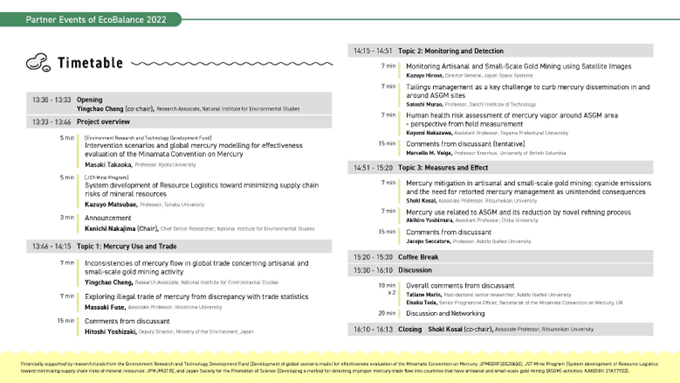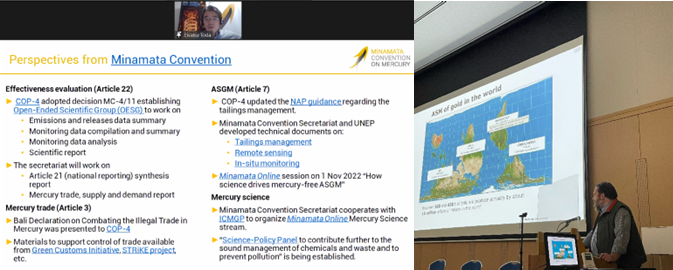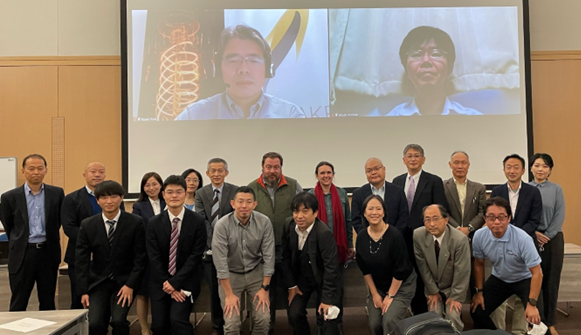Report of an event for international information exchange concerning artisanal and small-scale gold mining (ASGM)
November 29, 2022
1.Event overview
Date:October 30, 2022
Meeting format:Hybrid (offline and online)
Venue:Fukuoka Convention Center (Fukuoka, Japan) + Online (Zoom)
2.Participants and participating countries/territories
53 participants in total (mainly scientists, engineers and policy makers):
-15 presenters (experts) from Canada, Chile, Japan (including Ministry of the Environment and academic institutions), and the United Nations (Secretariat of the Minamata Convention on Mercury)
-38 audiences (offline and online) from Europe (TAUW), Japan, Taiwan, and the United States
(Environmental Protection Agency).
3.Summary report and future prospects
In order to enhance the understanding and management of anthropogenic mercury cycle, the National Institute for Environmental Studies (NIES) has been working on the project “Development of a Scenario Analysis Model for Effectiveness Assessment (SII-6-2, JPMEERF20S20620).” The Division has also been collaborating with various universities in Japan (i.e., Kyoto University, Ritsumeikan University, Hiroshima University, and Tohoku University) to estimate future mercury emissions, to identify inappropriate mercury trade, to propose measures for the reduction or elimination of mercury use and emissions, and to visualize social issues associated with resource use. Artisanal and small-scale gold mining (ASGM), which has been using the mercury amalgamation method*1, is one of the primary sources of mercury pollution. Since there are many inappropriate ASGM operations, including illegal, illicit, and unauthorized ones, many issues need to be addressed, including the necessity to understand their actual conditions and ASGM-derived mercury flows.
This event entitled “Mercury Legacy in Artisanal and Small-Scale Gold Mining”*2 was an official partner event of the International Conference on EcoBalance*3 whose 2022 meeting was held at the same venue. Among many issues associated with ASGM, some key issues related to the environmentally sound mercury management were presented: use and trade of mercury; monitoring and detection; and measures to improve the mercury management and their effectiveness. More detailed programs are as follows:
・Mercury use and trade: statistical inconsistencies of global mercury flow data regarding ASGM activities (two presentations);
・Current conditions of mercury flows in Japan (information shared by the Ministry of the Environment of Japan);
・Monitoring and detection of ASGM activities and mercury pollution (three presentations);
・Technologies to reduce or eliminate mercury use and emissions (two presentations); and
・Actual situations of ASGM: problems and countermeasures.
After these presentations comments were invited from the experts who had in-depth knowledge of countermeasure technologies to reduce and eliminate mercury use. The participants had lively discussion and gained deeper understanding on each topic based on the comments and opinions from the experts. This event helped them to mutually deepen the understanding of the challenges and research prospects for abolishing inappropriate mercury use and achieving sound mercury management in ASGM. The participants from various countries and territories shared the need not only to continue their efforts but also to further collaborate and proceed with social interventions, including technical assistance, to resolve the issues.
The Material Cycles Division will continue the research on the mercury flows related to ASGM in order to reduce its use, trade, emissions and release, and to contributes to the proper management of hazardous chemicals and improvement of the environment. The research and technical assistance will improve the understanding of actual conditions of ASGM, and contribute to the elimination of inappropriate global mercury flows and the realization of planetary health.
*1. A method to extract gold and silver from ores that contain these metals. In the case of gold extraction, elemental mercury is used first to extract gold from ores as mercury-gold alloy (called an amalgam), and then gold is recovered from them by evaporating the mercury.
*2. This event was financially supported by the Environment Research and Technology Development Fund of the Environmental Restoration and Conservation Agency of Japan (“Development of global scenario model for effectiveness evaluation of the Minamata Convention on Mercury: JPMEERF20S20620”), Japan Society for the Promotion of Science (“Developing a method for detecting improper mercury trade flow into countries that have artisanal and small-scale gold mining (ASGM) activities: KAKENHI 21K17922”), and JST-Mirai Program (“System development of resource logistics toward minimizing supply chain risks of mineral resources: JPMJMI21I5”) of the Japan Science and Technology Agency.
*3. This international conference is held every 2 years in Japan since 1994. It features lectures and presentations on research and survey results to reduce environmental impact of products and services throughout their life cycles. In 2022, the 15th EcoBalance International Conference (EcoBalance2022) was convened at the Fukuoka Cenvention Center from October 30 to November 2.
Related Research Papers
Nakajima K., Hanaoka T., Nansai K., Cheng Y. (2021) Baseline scenarios for global atmospheric mercury emissions from anthropogenic activities and issues surrounding emissions reduction. Material cycles and waste management research, 32(5), 376–383 (Japanese)
Cheng Y., Nakajima K., Nansai K., Seccatore J., Marcello M. Veiga, Takaoka M. (2022) Examining the inconsistency of mercury flow in post-Minamata Convention global trade concerning artisanal and small-scale gold mining activity. Resour. Conserv. Recycl. 185, 106461
Kosai S., Nakajima K., Yamasue E. (2023) Mercury mitigation and unintended consequences in artisanal and small-scale gold mining. Resour. Conserv. Recycl. 188, 106708
Fuse M., Oda H., Noguchi H., Nakajima K. (2022) Detecting illegal intercountry trade of mercury using discrepancies in mirrored trade data. Environ. Sci. Technol. 2022, 56, 19, 13565–13572
[Contacts]
【Inquiries about the research】
Kenichi Nakajima, Chief Senior Researcher
Global Resource Sustainability Research Section
Material Cycles Division
National Institute for Environmental Studies
Tomonori Ishigaki, Office Manager
Kae Inaba, Expert
International Waste Management Research Administration Office
Material Cycles Division
National Institute for Environmental Studies
【Inquiries about the press】
Public Relations Office
Planning Division
National Institute for Environmental Studies
E-mail: kouhou0(at)nies.go.jp
- What's New
- What's New 2025
- What's New 2024
- What's New 2023
- What's New 2022
- What's New 2021
- What's New 2020
- What's New 2019
- What's New 2018
- What's New 2017
- What's New 2016
- What's New 2015
- What's New 2014
- What's New 2013
- What's New 2012
- What's New 2011
- What's New 2010
- What's New 2009
- What's New 2008
- What's New 2007
- What's New 2006
- What's New 2005
- What's New 2004
- What's New 2003
- What's New 2002
- Event Information
- Visit NIES


